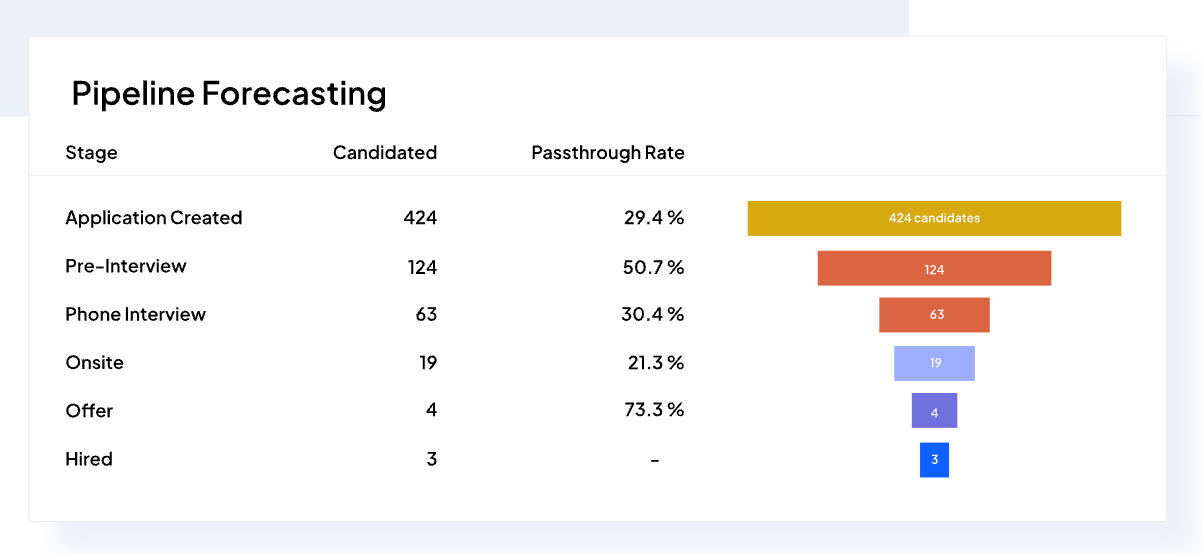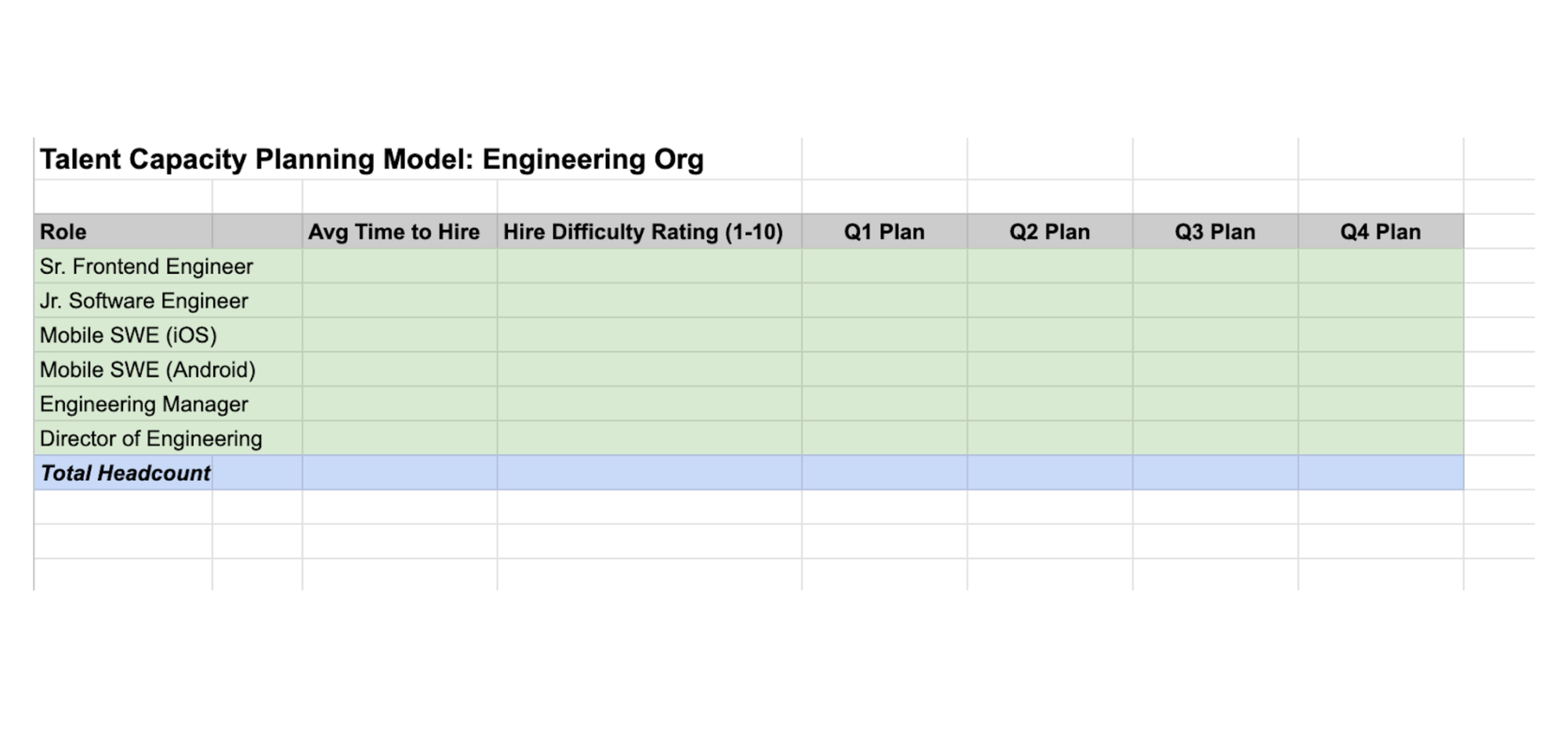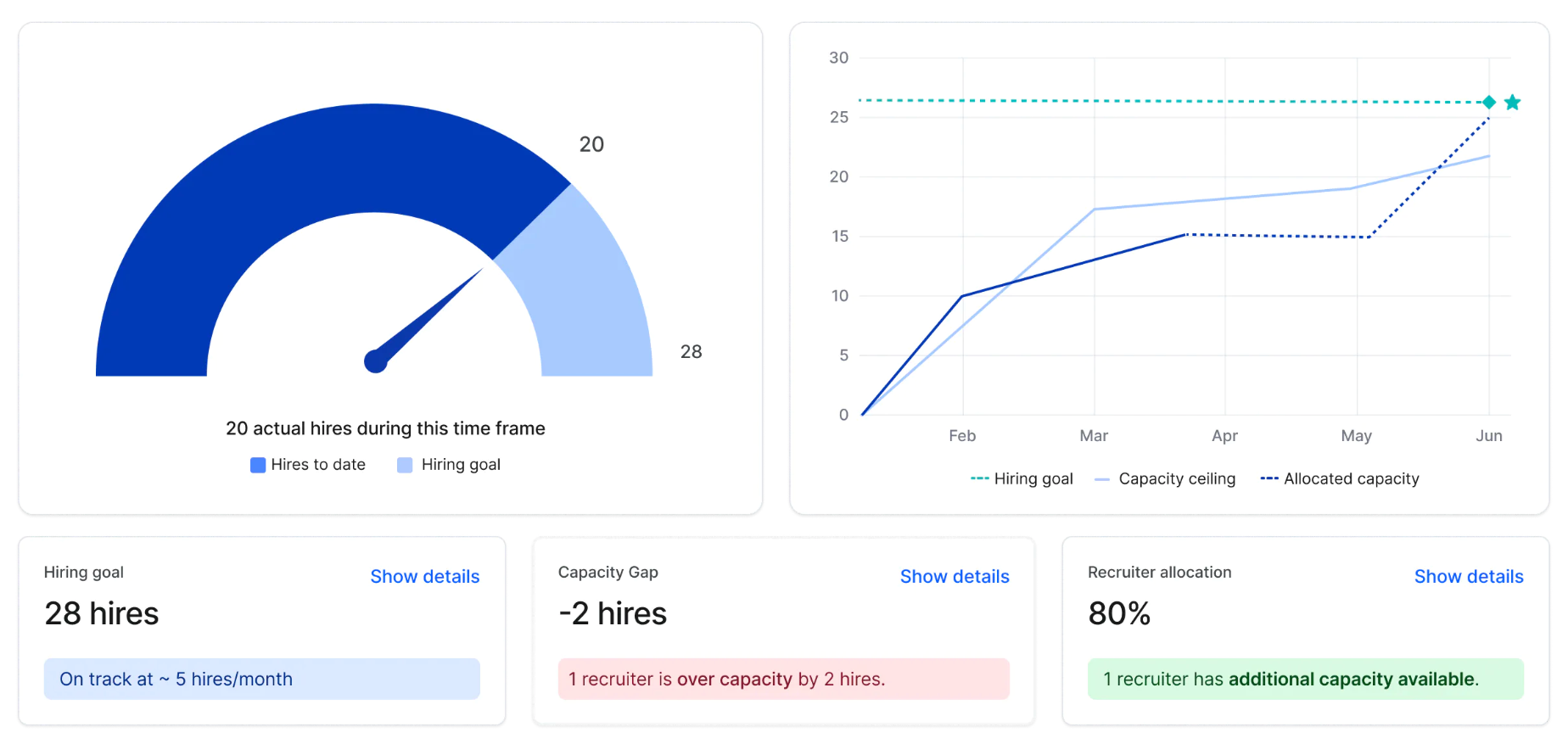Startups have developed a bit of an allergy.
Somewhere along the way, amidst the “move fast and break things” battle cry for hypergrowth, early-stage leaders have lost their tolerance for internal processes and structures.
There’s lots of well-intentioned advice out there about the risks if a business takes off and there isn’t a solid foundation to stand on. But at the same time, it's no surprise that startup leaders see words like "optimizing headcount through capacity planning models" and file it away as unnecessary bureaucracy that’s more befitting of the “BigCo” companies they’re downsizing from.
Talent acquisition is one of these startup functions that is brimming with business jargon like this, but only because the very core of talent is to operate towards a future version of a company — a scale and maturity that doesn’t exist yet. Without the right tooling and models in place, recruiters aren’t able to align their work closely to what’s most important to the business.
As a decades-long tech recruiter and talent acquisition leader, Richard Cho has led talent orgs at Robinhood, Facebook, Dropbox and Gem and currently works as EVP of Talent Acquisition at Charlie Health.
Through both hiring frenzies and famines, he’s had a front-row seat to what happens when high-growth startups don’t take the time to bake in frameworks for their recruiting strategies.
“We see a cycle in tech all the time,” Cho says. “Hiring trends start with moderation and then due to market changes, all of a sudden there is a hiring frenzy. Everyone’s fighting for the same people. We see a rise in salaries, scarcity mindsets, and a hire-at-all-cost mentality. Then, just as inexplicably as it started, we see a down cycle. Suddenly, it’s stop hiring at all costs, executives are drawing up layoff plans, and it shifts back to hiring with moderation.”
Yet, no matter how many times the cycle repeats (Cho, who has been working in recruiting since before the dot com bubble burst in the early 2000s, has seen four of these), there never seems to be a meaningful change to how startups and tech companies approach their headcount plans.
The piece that has been missing in the four times that I’ve seen this boom-and-bust cycle is that recruiting orgs have yet to be in direct alignment with business and finance leaders around when they can expect hiring to restart.
To close this alignment gap between talent teams and the rest of the business, Cho makes the case for adding small, incremental bits of structure in the short term, which will save startups the headaches that come from poor talent infrastructure in the future.
In this exclusive interview, Cho combines nearly two decades of experience as a talent acquisition leader into one thoughtful guide on making talent teams more efficient. With the right combination of data and automation, talent teams can pick up habits that help them better track their spend, prove ROI and get more strategic with limited resources.
Almost all of Cho’s tactics are very startup-friendly (all you need is access to a spreadsheet and some time on your calendar every week) but they are also buildable, designed to grow as you go.
He starts by sharing the secret weapon every recruiter should have in their back pocket: the capacity planning model. Through anecdotes from his time working at late-stage recruiting teams, he unpacks the messes he’s cleaned up and how they could have been avoided with a little bit of planning earlier on. He goes on to share three different tiers of a capacity plan (beginner, intermediate and advanced) providing a simple way to flex it up and down to suit your startup’s needs.
Whether you are the first talent leader at an early-stage startup or you are at a later-stage firm re-evaluating the way things have always been done, Cho shares plenty of tactical habits that are easy to introduce from the get-go.
THE CAPACITY PLAN: AN EFFICIENT TALENT TEAM’S SECRET WEAPON
Companies (especially startups) are constantly changing, and in the best cases, growing.
For talent teams, that means the number one process that’s top of mind is hiring. Typically, founders come to talent leaders with a hiring plan and a budget, and it’s the recruiter’s job to make magic happen. But things start to go awry when the budgeting process hasn’t been adapted to loop talent leaders in.
“A typical headcount forecast starts in Q3, is finished in Q4, and is finalized in Q1,” Cho says. “This means that recruiting teams — who are sometimes the last to know when the final forecast is approved by the board — can’t start responding to that forecast until sometime in the middle of Q1, putting recruiting teams months behind before they even can post a job description.”
Plus, there’s all the time it takes to source candidates, review applications, and complete interview loops. According to Cho, at a mid-to-large-size tech company, it takes an average of 45 days to find and hire new folks, and 90 days before they are seated at their desk, ready to add value. All of this tacks on days, weeks and months to execute on the original headcount plan.
“If recruiting teams aren’t fully ramped up with the information they need to do their jobs until partway through the year, the company is now at a severe disadvantage to hit their goals,” Cho says.
Even when headcount forecasting goes off without a hitch, talent is still operating many quarters behind. And more often than not, that best-laid hiring plan way back in Q3 is quickly tossed out the window when the product roadmap or the market changes on a dime.
“This is where it pays to have a reliable capacity planning model,” Cho says. Commonly used in finance and sales teams alike, capacity planning is a resource that — when used correctly — can help talent teams avoid overhiring and adapt quickly as priorities shift.
If efficiency is the name of the game, then developing a model recruiters and founders can depend on for scaling the team is paramount. “Having a reliable capacity planning model allows talent leaders to have meaningful conversations with other business leaders about where more resources are needed and align on the company goals behind each hire,” Cho says.
Capacity planning gives everyone a shared framework to have conversations around whether the company is growing and investing in the right areas, which is the key to solving broken hiring cycles.

3 REASONS YOUR RECRUITING STRATEGY ISN’T AS SHARP AS IT COULD BE
So much of working in startups is maneuvering around tight corners, being careful not to let competitors pass you on the inside lane. But no matter what function you work in, if you’re doing the same tasks day after day, it's all too easy to develop blind spots that can end up costing you.
After joining several late-stage startups as a recruiting leader, Cho has picked up on the most common missteps. Based on real messes he’s had to clean up, here are three of the most common traps he’s seen recruiters fall into, and how to make sure you don’t end up with a malfunctioning capacity plan in the future.
Reason #1: You spend too much time focusing on hiring outcomes
Ask anyone working at an early-stage startup what they wish they could have more of. The answer will unequivocally be time. In any role, there are always a million things to check off the to-do list and strategy work almost always gets bumped down to the bottom of the pile. For talent leaders at early-stage companies, focusing on hiring outcomes eats away the majority of their time.
“Typically, the first talent leader at a startup is tasked with both setting up the foundation of recruiting, but also they are hands-on and own requisitions,” Cho says. “It’s really easy to fall into this trap of focusing on execution, and doing minimal things like setting up your ATS, because early talent leaders are laser-focused on hiring outcomes and not so much what it takes to get there.”
But Cho urges early talent leaders especially to re-consider what they move to the top of their list. When preparing for the scale to come, it’s essential to lay the groundwork well in advance. “If your company is successful, inevitably you’re going to get into a hiring round that requires you to think intelligently about how many resources you need per hire,” Cho says.
But strategy work doesn’t need to happen overnight. Cho offers a few low-lift tactics that talent leaders can use to easily embed into their day-to-day:
- Be a partner to your hiring managers. “Recruiting is complex,” Cho says. “Do not assume everyone understands what inputs will affect hiring outcomes. By setting up a regular cadence to go over what’s on your hiring dashboard, you will effectively teach cross-functional folks the nuances of your capacity plan and open up the dialogue for strategic conversations about the business.” Use this time to review what is and isn’t working in the hiring process, and make a plan to course correct when needed.
- Book Quarterly meetings with leadership. “Beyond the weekly meetings, I do quarterly business reviews with each and every business function,” Cho says. “In the very early stages of startups, I tend to do weekly reviews with founders as well. These conversations focus more on conversions — or in other words — how many candidates make it to the next stage of the hiring process and why. This helps talent stay on the same page with leadership on hiring goals going forward.”
- Check your stats over your morning coffee. “Talent performance used to be based on pure outcomes. In the last 10+ years that’s all we did. Now we have to proactively preempt issues in the funnel itself, which means talent leaders need to be looking at analytics every day. I’ve asked my analytics team to create my own talent dashboard. It will highlight in yellow and red the areas that I need to dig into. I open that dashboard up every morning. I go into thinking ‘ok this number seems a little off…why? That’s what sets my course of action for the remainder of the day.”
The advice I’d give to the first talent leader at a startup is to be wary of falling into the trap of execution. Leave yourself the time to strategize.
Reason #2: You’re skipping over important funnel metrics
If the bulk of recruiters’ time is designed to focus on hiring outcomes, then it’s no surprise that the most common data point talent teams collect is the number of hires. While a healthy hiring funnel definitely includes tracking this metric, relying solely on just one number diminishes how robust a recruiting strategy can actually be.
“Usually when I inherit a new talent team, they have very little data and almost always have no funnel metrics. Zero,” Cho says. “When I joined Robinhood, there was already a team of 14 people. At a very high level, they knew that one recruiter had hired 40 people, but had no idea what roles they were.”
But as companies inevitably start to grow, recruiters will be expected to answer questions that require a more sophisticated data tracking system. “I knew full well that my model wasn’t as accurate as it could be when people started to ask about certain talent verticals. I was starting to get questions from senior management like ‘How is our CS team growing?’ or ‘How many resources does it take to have X amount of output?’”
That’s why it’s essential to build a robust funnel for each sub-category, he says. This can end up saving months of recruiter time tracking down the historical data needed to justify better resources for the talent team. A comprehensive funnel looks at the entire hiring experience from beginning to end — how many candidates pass a resume review? How many people pass the phone interview? How many candidates reject a job offer?
“If you don’t have a certain level of detail, then you lose credibility with the finance team and the rest of the business. Capacity planning requires constant testing and iterating. The most important goal is accurately predicting what’s needed to hire each role.”
There can be a misperception of how healthy a hiring funnel is when recruiters only look at the highest level of hiring metrics. The devil is in the details; it's not always obvious why certain conversions are below average.
Reason #3: There’s a fundamental lack of alignment between talent and the core business
Imagine a founder or senior executive has placed new emphasis on a demanding data querying project. In order to get the project shipped on time, leadership has decided it would take three data engineers working in tandem and the goal would be to cross the finish line by the end of the first quarter.
Historically, you know as a talent leader that the timeline from candidate outreach to a fully-onboarded data engineer spans much longer than 90 days. You aren’t quite sure where or how leadership came up with this hiring deadline, but you know you are now being tasked with working within its boundaries. How do you respond?
“A lot of misalignment has to do with finance and business leaders not knowing the intricacies of the hiring process,” Cho says. “For instance, they might not know the nuances between hiring a senior engineer versus a junior one, or an SDR versus a person in the marketing org.”
Cho says the best thing recruiters can do is make these strategic conversations happen. “Without those expectations set across the board, you waste time retroactively building that understanding for finance teams.” (And you’ll probably lose out on getting key resources your team needs to hire during those quarters too.)
Establishing a regular cadence of communication between finance and talent is critical, Cho says. Simple actions, like scheduling a recurring meeting on the calendar or sending weekly Slack updates to a shared channel on what a hiring process looks like, can make the difference of a talent team getting no resources, to more than enough.
One more tactical tip here is to always attach your capacity plan to every calendar invite or meeting agenda. “Make the capacity plan available to everyone in the business, and use it as a shared language all stakeholders can use when talking about hiring goals,” Cho says.
HOW TO LEVEL UP WITH A CAPACITY PLAN
On its own, a system for tracking your organization’s talent plan keeps business leaders focused, detail-oriented and organized. But a capacity plan’s real power comes into play as the organization starts to scale, cementing the talent organization’s seat at the table as a strategic and vital business function.
The playbook for running a responsible headcount plan isn’t too far off from a machine learning algorithm. “In the beginning, it might spit out errors, but the more time you spend creating more sophisticated models, the smarter and more accurate predictions you can develop for resources over time. And eventually, you’ll get to a place where you are modeling by requisition.”
1. BEGINNER: Start with perfecting your hiring funnel
The first step to approaching a new headcount plan, whether you are a founding talent leader at a startup or if you’re inheriting a leaky hiring pipeline, is to understand your hiring funnel forward and backward.
“You can imagine it looks just like a sales funnel,” Cho says. “The very top of the funnel is prospecting — these are your potential new candidates. In the middle of the funnel is all the steps you do to qualify the candidate. And the bottom funnel is when you make an offer and the candidate accepts. The key thing is to create this structure — even if you are a team of one — because understanding the conversion rates to cross those phases will give you clues on where you can optimize.”

Cho’s secret ingredient to optimizing here is to create a new funnel for every role.
“At the very high end, you may have a talent funnel for your most prioritized functions, which could look like one for engineering and another for ops,” he says. “This will help you see a bigger narrative when analyzing your funnels. Look at the conversion rates for every function (both the numbers and the percentages) and use this to start providing estimates for when you believe these hires will be ready to log on for their first day.”
Don’t worry about creating anything fancy here. The important thing is to get your funnel down on paper, so you can get into the habit of inputting and collecting data when it comes your way.
“What I recommend is to create a simple capacity model using spreadsheets. The most important metrics to track are the effort and the time it takes to hire any individual by role. Because when the business starts rapidly growing and you are eventually asked to increase by 30% or, in some cases, by 100% output, you will have clear data to justify the resources, tools, and areas for process improvement you need to get to that output. That is best portrayed in the model you’ve created.”
For a more visual exercise that can help map out exactly what hires you need and when, try plugging in top priority roles into a super simple capacity template.

2. INTERMEDIATE: Layer in more candidate data
At this point, your model should be pretty reliable for tracking the time and resources it takes to hire for every role in your company. But there’s always room for improvement. Let’s use engineering as an example. Cho walks through all the different branches that can stem from the original seed of your headcount plan.
“In the beginning, let’s say you take that first step of iterating the model. You went from a blanket goal of hiring a certain number of engineers to a more detailed plan where non-technical recruiters can hire X people and technical recruiters can hire Y people per quarter,” Cho says.
The next layer down is within those two branches. “Let's follow the technical role: sort through how many engineers you need vs. product managers vs. designers. Then the model starts to get more sophisticated. Continue to build and maintain that model.”
The next layer digs into candidate levels. “For each role, how many level-one engineers can we hire? How many level-three engineers vs. principal engineers? Now this is the beginning for also setting performance goals for your talent team.”
“Remember, this model can be as complex as you want it to be,” Cho says. “You can keep going, adding in resources and goals to whatever level of specificity you want. Front end vs. back end engineers, machine learning specialists vs. data scientists.”

“I knew it was time to add in new layers of data because of how varied each function was in terms of output. A recruiter that supports customer success likely has the ability to hire 20-30 CS people per quarter, whereas an engineering recruiter might only be able to make 2-3 hires in the same time period.”
Not unlike a product manager’s process, tracking how many candidates were trickling down through the hiring process can clue recruiters into what they need to optimize.
“You want to be able to create a model where you can filter by a specific area in the hiring pipeline. For example, if the company is full steam ahead on hiring engineers, but there’s a steep drop off in candidates after the initial phone screen, that can clue everyone in that the screen might have to be adjusted to bring in more candidates.”
Try tweaking your funnel by revenue impact
If you’ve got hiring funnels by function and role down pat, another practice to level up your capacity plan is to create a dashboard view for roles that directly impact revenue for the business.
“You can always further refine your model based on how important certain groups are to your business strategy. Here at Charlie Health, the two groups that directly impact our ability to create revenue are therapist hires and go-to-market representatives. Anytime our forecasts are out of sync with our ability to hire talent in those areas, it creates huge flags for the business.”
3. ADVANCED: Invest in tooling and automation combined with full-time strategy work
As your company continues to grow, or the demand for hiring starts to pick up the pace, it’s time to level up your simple model with better tooling and more layers of data.
Cho likes to drive the point home that at this stage, what founders are investing in is their recruiter’s time and efficiency. “Real recruiting is relationship-based, and that takes a significant portion of time. Investing in powerful tools can lift the burden of recruiters manually manipulating spreadsheets and give them that time back to focus on relationship building.”
If you are working with a bit more flexible budget or have founders that have committed resources to building out a robust headcount model, you may be able to lift the burden of some of this documentation with bespoke hiring funnel tools. If you’re not sure what is out there, Cho lists a couple of trusty shortcuts to lean on:
- CRM software that is built specifically for talent teams (Like Gem, Talent Wall or Ashby)
- Asking developers on your team to create an internal data warehouse, where querying specific data is possible.
- Bringing in outside help, such as recruiting agencies, to focus on hiring outcomes so you can focus on the data and strategic side.
“These tools help to capture data that is critical to your model, but recruiters still have to build a robust data warehouse to manage this,” Cho says.
It’s not hard to imagine the level of detail this model can distill down to. All of this data, when routinely inputted and checked, can lead to fairly complex models to help talent leaders run analyses in the backend.
“You’ll start to have a level of confidence in your plan’s output that is unmatched,” Cho says. “It doesn’t happen overnight. It takes many months and years to get there. But with the proper data input from the start, this is the path your model can take.”
If someone were to come to you and say “I want to hire a director of engineering for our company that can manage a team of 20,” you have a model that can pretty accurately tell them how long and what resources it would take for that to happen. That’s what ultimately makes the recruiting team credible.
In Cho’s experience, he’s too often seen talent acquisition cast off as either a service or an administrative function. This has a domino effect on how recruiters view their role in the organization.
“The expectations laid on recruiters have been to deliver on hires, and that’s it. Full stop — no other value proposition,” Cho says. “And so early talent leaders are caught between having to execute on the needs of the business (just fill 20 requisitions) and their performance is gauged on whether you filled them or not.”
He encourages founders and other senior leaders to place less emphasis on quantity and more on filling roles in a high-quality way.
Instead of the talent team asking, ‘Can we deliver against these goals?’ talent leaders should feel empowered to ask, ‘But is this goal right for the organization?’
